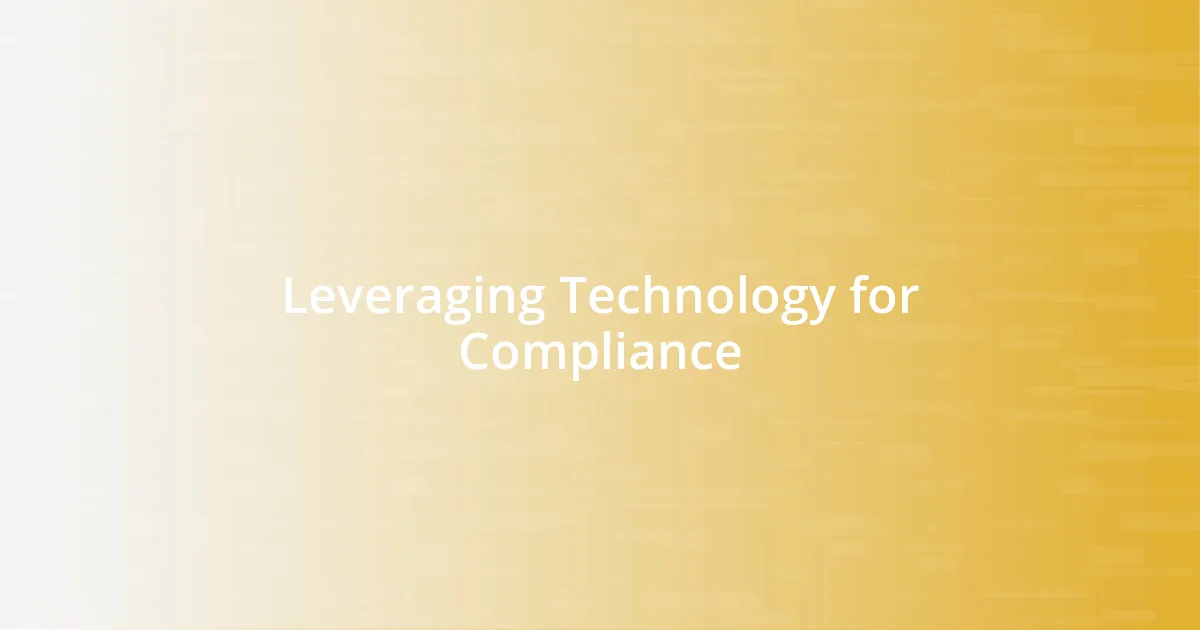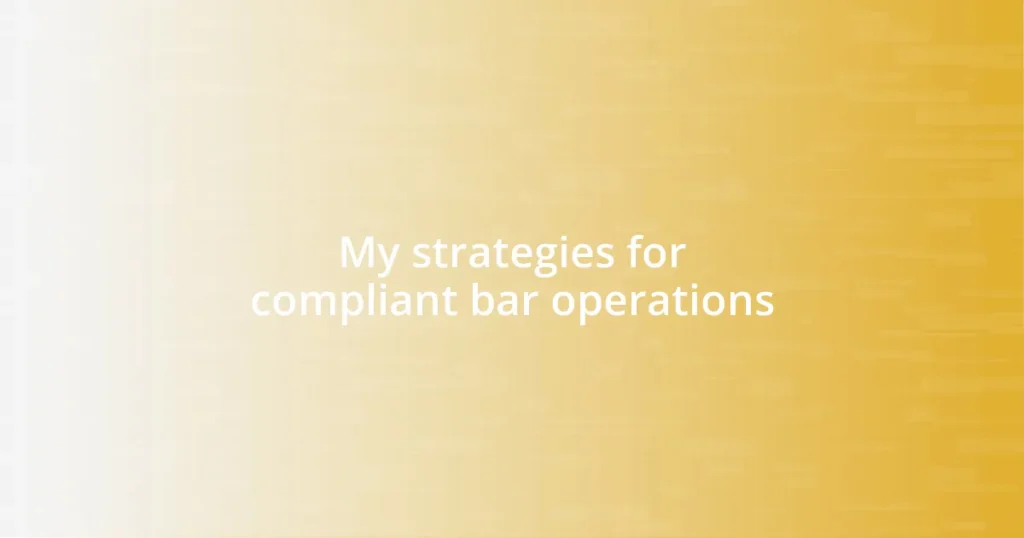Key takeaways:
- Understanding and adhering to local compliance regulations are essential for maintaining a positive reputation and successful bar operations.
- Developing comprehensive employee training programs and involving staff in procedural updates fosters a culture of compliance and enhances team ownership.
- Implementing effective inventory controls and conducting regular compliance audits help identify discrepancies and ensure proactive management of compliance issues.
- Building relationships with local regulatory authorities through open communication and networking can enhance understanding and cooperation regarding compliance requirements.

Understanding Compliance Regulations for Bars
Understanding compliance regulations for bars isn’t just a box to check; it’s a vital part of running a successful business. I remember my first few months managing a bar, overwhelmed by the myriad of rules. Who knew that even something as simple as serving alcohol at events required a specific license?
One crucial aspect of compliance is adhering to local laws regarding alcohol sales and service. I once had a close call with an inspection, and I felt my heart race as the inspector reviewed our practices. It was a wake-up call that made me realize how easily things can slip through the cracks if you aren’t vigilant. This experience taught me that being proactive about these regulations isn’t just smart; it’s essential for maintaining a positive reputation.
Moreover, keeping track of employee training and responsible serving practices makes a world of difference. Have you ever thought about how compliant staff can turn a potential compliance issue into a positive customer experience? I can’t tell you how many compliments I’ve received when patrons notice our team handling ID checks with care. It’s not just about avoiding fines; it’s about building trust within the community.

Developing a Comprehensive Training Program
When developing a comprehensive training program, I find it’s essential to consider the diverse range of topics that touch upon compliance. From understanding service laws to mastering proper alcohol handling techniques, each section plays a pivotal role. A memorable training session I conducted revolved around mock scenarios, allowing my team to practice real-life situations. Watching their confidence grow as they navigated these challenges was incredibly rewarding.
Here are some key components to incorporate into your training program:
- Compliance Knowledge: Educate staff on local and state regulations regarding alcohol service.
- Practical Scenarios: Use role-playing exercises to familiarize employees with real-world situations.
- Customer Service: Emphasize how compliant practices elevate customer experiences.
- Policy Review: Ensure everyone is aware of the bar’s specific policies and procedures.
- Regular Refreshers: Schedule ongoing training sessions to update staff on new rules and reinforce existing knowledge.
By combining these elements, you not only build competence but also foster a culture of compliance that permeates your bar’s atmosphere. It truly changes the game when your staff feels equipped with the right tools to succeed.

Implementing Effective Inventory Controls
Implementing effective inventory controls is a game-changer in ensuring compliance and avoiding costly mistakes. I vividly recall the chaos during my first stocktaking session; I had no clue how much product we actually had, and it felt like I was grasping at straws. Implementing a systematic inventory system allowed me to pinpoint discrepancies fast and manage costs more efficiently, giving me a newfound sense of control that is invaluable.
Another strategy I found useful is setting up regular audits and using technology to streamline the process. For instance, employing a point-of-sale (POS) system that integrates with inventory management helped me track sales in real-time. This setup not only ensures that stock levels match sales but also gives insights into trends that affect my ordering decisions. Honestly, it felt like having a crystal ball for what was selling, and it made a tangible difference to my bottom line!
Lastly, creating a culture of accountability among staff has a profound impact on inventory management. I remember a day when my bartender noticed discrepancies in the drink inventory and promptly reported it. This proactive attitude not only saved money but also fostered team ownership over our operations. Empowering my employees to take charge has always paid off, enhancing our compliance and operational efficiency.
| Control Method | Benefits |
|---|---|
| Systematic Inventory Tracking | Reduces discrepancies, boosts confidence in stock levels |
| Regular Audits & Technology | Provides real-time sales data, informed ordering decisions |
| Employee Accountability | Encourages proactive behavior, fosters a sense of ownership |

Establishing Clear Operational Procedures
Establishing clear operational procedures is something I believe is fundamental to running a compliant and efficient bar. I recall a time when our team encountered confusion during busy weekend shifts due to a lack of clarity in our processes. By laying out straightforward, step-by-step procedures—whether it was for serving drinks or handling customer complaints—I saw a significant decrease in errors and an increase in team confidence. It was gratifying to witness my staff seamlessly navigate through those hectic nights.
I’ve learned that it’s not just about writing procedures; it’s crucial to involve the entire team in the development process. When I opened the floor for input on our operational procedures, the insights from my staff were eye-opening. They had firsthand experience of what worked and what didn’t, allowing us to create procedures that felt practical and applicable. Involving everyone not only enhances compliance but also instills a sense of ownership among the team.
Regularly reviewing and updating these procedures keeps them relevant and effective. Reflecting on my own experience, I remember how a simple quarterly review session transformed our operations. We collectively assessed what procedures needed tweaking based on evolving laws and customer feedback. This practice not only ensured compliance but also fostered an environment where everyone felt comfortable suggesting improvements. Isn’t it amazing how simple conversations can lead to large shifts in operations?

Leveraging Technology for Compliance
Integrating technology into compliance strategies has been a transformative journey for me. I often reflect on my early days when I relied solely on paper logs for tracking our operations. The shift to cloud-based tools was like a breath of fresh air; I could access vital information in real-time, making it easier to adhere to local regulations. Have you ever experienced that sigh of relief when a complicated task becomes simple? That’s what technology can do for compliance—streamlining processes and reducing the likelihood of errors.
Another standout moment for me occurred when I adopted a compliance management software. It was initially daunting, but once I got the hang of it, I realized how much easier it made monitoring compliance issues. The software provided automated reminders for permits and licenses that were due for renewal. Honestly, it felt like having a personal assistant dedicated to keeping everything in check. Wouldn’t we all love a little extra help in managing deadlines?
Moreover, using mobile applications for employee training and updates has made a huge impact on our compliance culture. When I first rolled out an app that provided easy access to our operational guidelines, I was pleasantly surprised by the engagement levels among my staff. They could review protocols right on their phones, making compliance feel less like a chore and more like a team effort. Isn’t it fascinating how technology can transform a mundane requirement into a dynamic part of our daily operations? It’s rewarding to see everyone on the same page, enhancing both our compliance and teamwork.

Conducting Regular Compliance Audits
Conducting regular compliance audits has been a game-changer for my bar operations. I vividly recall the first audit I implemented; it felt a bit intimidating at first, like the HR police were coming in to scrutinize every detail. However, I soon discovered that these audits revealed overlooked areas, from outdated licenses to gaps in employee training. The relief of knowing we were tackling compliance proactively instead of reactively is indescribable. Isn’t it reassuring to know that your operation is running smoothly and legally?
One audit brought to light that our staff wasn’t fully aware of updating food safety protocols, which led to swift corrective actions and a complete training refresh. I remember how proactive conversations with team members turned anxiety into empowerment. Engaging my staff in the audit process not only boosted compliance but also transformed their outlook; they felt more informed and invested in keeping our bar up to standard. Have you seen how collaboration can spark ownership?
What I’ve learned is that scheduling these audits regularly—whether monthly or quarterly—creates a culture of accountability. Initially, I worried my team might perceive it as micromanagement, but I’ve found the opposite to be true. The audits have turned into collaborative sessions where we share feedback and celebrate our achievements. It’s like having a team bonding experience around compliance! Trust me, making audits a norm will bring you peace of mind, and your bar operations will truly thrive.

Engaging with Local Regulatory Authorities
Engaging with local regulatory authorities has taught me the importance of building relationships, not just ticking boxes. I recall my first meeting with a representative—it felt more like a networking event than a compliance discussion. The more I learned about their expectations and processes, the clearer it became that fostering open communication could make a world of difference. Have you ever felt that spark when meeting someone who genuinely cares?
I make it a point to attend local regulatory workshops and forums regularly. Not only do I stay updated on regulations, but I also get to know the faces behind the policies. One memorable session involved a Q&A that addressed common misconceptions about permits. I was struck by how engaged the officials were, eager to clarify and share insights. That experience highlighted my belief: when you treat these authorities as partners, it benefits everyone involved.
Furthermore, I’ve found that following up with regulators after our interactions cements the relationship. For instance, I once sent a thank-you email after a particularly enlightening meeting. The response was welcoming and led to casual chats about future regulations. I realized that a small gesture can lead to a deeper connection. Isn’t it rewarding when compliance becomes a two-way street?















